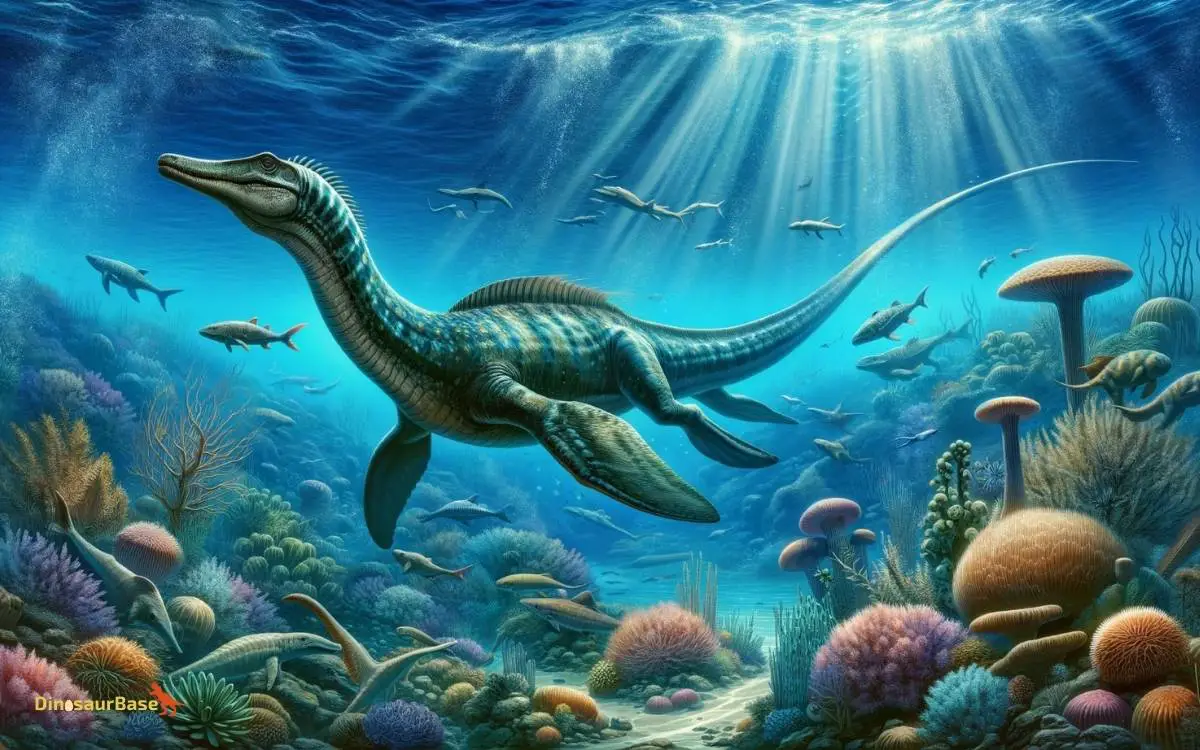How to Identify Which Dinosaur Lives in Water: A Complete Guide
To identify aquatic dinosaurs, focus on their adaptations such as webbed feet or streamlined bodies. Fossil evidence and paleontological studies are key to determining their habitats.
Understanding which dinosaurs were adapted to aquatic lifestyles has fascinated both the scientific community and the public alike.
Diving into the realm of prehistoric life, the thrill of uncovering dinosaurs that thrived in ancient waterways is unparalleled.
Paleontology sheds light on these extinct species through careful examination of fossil records and bone structures.
Unearthed remains provide clues to the existence of semi-aquatic or fully aquatic dinosaurs, revealing their unique physical characteristics.
Enthusiasts equipped with this knowledge can easily pinpoint the dinosaurs that once dominated earth’s water bodies.
This guide offers insights into the fascinating discovery process, equipping readers with essential tools to identify these remarkable creatures of the distant past.

Myths And Facts About Aquatic Dinosaurs
Welcome to our dive into the prehistoric depths where dinosaurs ruled not just the land, but also the waters.
Understanding aquatic dinosaurs leads to fascinating discoveries and some surprising myth-busting. Let’s separate fact from fiction in the mysterious and murky world of these ancient creatures.
Popular Aquatic Dinosaur Misconceptions
Many believe all large reptiles from the dinosaur era were dinosaurs. This isn’t true. Iconic names like Plesiosaurus and Mosasaurus come to mind; though they swam the ancient seas, they weren’t true dinosaurs.
- True dinosaurs walked on land, even if they sometimes lived near water.
- The term ‘swimming dinosaurs’ can be misleading.
- Actual dinosaurs did not have flippers but limbs for walking.
Another common error is the ‘Loch Ness’ association, picturing dinosaurs with long necks as aquatic. Nessie’s resemblance to Plesiosaurus might be strong, but Plesiosaurus does not fit the dinosaur category.
Recognized Water-dwelling Dinosaurs
Turning to fact, certain dinosaurs are known to have thrived in aquatic environments. Spinosaurus stands out with evidence pointing to its swimming ability.
| Dinosaur | Habitat | Notable Features |
|---|---|---|
| Spinosaurus | Riverbanks, lakes | Long, crocodile-like skull, paddle-shaped tail |
| Baryonyx | Wetlands | Sharp claws, fish-eating teeth |
| Suchomimus | Near water sources | Extended jaw, conical teeth |
These theropods had adaptations like specialized teeth or claws for catching fish. While they thrived near water, they did not fully adapt to a life aquatic like whales or dolphins in today’s world.
Anatomical Features Of Aquatic Dinosaurs
Dinosaurs are a diverse group, with some incredible species adapted to life in water. To identify these aquatic dinosaurs, it’s crucial to understand the anatomical features that allowed them to thrive in this environment.
In this guide, we’ll dive into the adaptations and structures that are key indicators of a dinosaur’s aquatic lifestyle.
Adaptations For Swimming
Swimming adaptations are vital for aquatic life. Aquatic dinosaurs had features that made them streamlined swimmers.
Their bodies evolved to move effortlessly through water.
- Webbed feet: Helped in paddling through water.
- Flattened tails: Provided stability and propulsion.
- Dense bones: Aided in submerging and buoyancy control.
Respiratory Structures For Aquatic Lifestyle
To thrive underwater, dinosaurs required specialized respiratory structures. These facilitated oxygen intake both at the surface and below the waves.
- Nostril position: High on the head, allowing for easy breathing while submerged.
- Lung capacity: Larger lungs supported deep dives and longer periods underwater.
Limb And Tail Design
The design of limbs and tails was crucial for aquatic movement. Let’s explore the specific traits related to this aspect.
| Limb/Tail Feature | Function |
|---|---|
| Paddle-like limbs | Enhanced maneuvering in water |
| Flexible tails | Increased propulsion efficiency |
Understanding these anatomical features offers clues about which dinosaurs were designed for an aquatic way of life. Recognizing paddle-shaped flippers or hydrodynamic bodies helps identify species adapted to the depths of ancient waters.
Habitat Clues And Fossil Evidence
Delving Into the prehistoric world, uncovering the mysteries of dinosaurs that roamed the earth is thrilling.
When it comes to dinosaurs that lived in water, habitat clues and fossil evidence are like pieces of a puzzle.
et’s explore how these pieces come together to paint a vivid picture of these ancient aquatic creatures.
Sedimentary Rock And Fossil Formation
Fossils tell stories of the past. Sedimentary rocks are often fossil keepers. They form from particles that settle in water.
- Look for shale, limestone, and sandstone.
- These rocks can encase remains of water-dwelling dinosaurs.
- Dino prints might be found on ancient riverbeds.
Paleoenvironment Reconstruction
Scientists are like detectives. They put clues together to reconstruct ancient habitats.
- Analyze rock layers for grain size and sediment type.
- Study plant fossils around dinosaur remains.
- Fossilized swimming tracks mean water was near.
These methods uncover the secrets of the dinosaur’s surroundings. They can show if a dinosaur lived in water.

Credit: www.amazon.com
Case Studies Of Known Aquatic Species
Identifying which dinosaurs lived in water requires a deep dive into paleontological research. Our case studies focus on species with strong aquatic links.
Spinosaurus: The Semi-aquatic Predator
Spinosaurus, known from North African fossils, was a giant that stalked both land and water.
- Distinctive features: Long crocodile-like snout, conical teeth, and a sail-like spine.
- Adaptations: Paddle-shaped feet for swimming and nostrils on the middle of the snout.
- Fossil evidence suggests a diet of fish and other aquatic prey.
Plesiosaurs And Mosasaurs: Rulers Of The Cretaceous Seas
Plesiosaurs and mosasaurs were not dinosaurs but prehistoric marine reptiles.
| Plesiosaurs | Mosasaurs |
|---|---|
| Long necks, small heads | Streamlined bodies, large jaws |
| Paddle-like limbs | Flippers and forked tails |
| Evidence: Fossilized stomach contents | Evidence: Bite marks on preys |
These reptiles dominated as apex predators, ruling the seas and hunting with precision.
Tools And Techniques For Identifying Marine Dinosaurs
Curious about the giants that once roamed the seas? Unearthing the mysteries of marine dinosaurs starts with the right set of tools and techniques.
Modern paleontologists use groundbreaking methods to determine which dinosaurs lived in water. Discover the fascinating ways scientists dive deep into the prehistoric past.
Modern Paleontology Methods
Digging into the depths of our planet’s history requires advanced technology. Paleontologists employ several modern methods to identify marine dinosaurs:
- 3D Imaging: Creates detailed models of fossils.
- Computer Simulations: Helps visualize dinosaur movement in water.
- Scanning Electron Microscopes (SEM): Provides high-resolution images of dinosaur bones.
Isotope Analysis And Diet Traces
Isotope analysis and diet traces are like detectives solving a prehistoric puzzle. These are crucial in understanding the life of marine dinosaurs:
- Oxygen Isotopes: Reveal sea temperatures and dinosaurs’ living conditions.
- Carbon Isotopes: Offer clues about what dinosaurs ate.
- Stomach Content Examination: Shows actual diet and prey choice.
Fossilized feces, known as coprolites, also provide insight into the diet and habitat of marine reptiles.
| Tool/Technique | Use | Information Gathered |
|---|---|---|
| Isotope Analysis | Examines fossil chemistry | Habitat and diet information |
| SEM | Analyzes bone structure | Marine adaptation features |
| Diet Traces | Studies coprolites and stomach contents | Feeding habits and prey |
Connecting Present To Past: Modern Aquatic Reptiles
The world beneath our waves teems with life, some remarkably similar to the dinosaurs of ancient oceans.
Modern aquatic reptiles act as living clues to the past. Let’s explore these connections and see what they tell us about the dinosaurs that ruled the seas.
Comparing Modern Reptiles With Ancient Counterparts
To unravel the mystery, we compare today’s marine reptiles with prehistoric fossils. Shape, size, and structure shed light on these ancient beings.
| Modern Reptile | Features | Dinosaur Counterpart |
|---|---|---|
| Sea Turtles | Paddle-like limbs | Protostega |
| Marine Iguanas | Powerful swimmers, salt glands | Ichthyosaurs |
These similarities help us visualize the world of water-dwelling dinosaurs.
Evolutionary Links Between Dinosaurs And Present-day Marine Life
Sea creatures today carry genetic echoes from dinosaur relatives. DNA patterns reveal fascinating tales of evolution.
- DNA comparisons help us trace lineage.
- Fossil records strengthen these connections.
- Mutations show adaptation to aquatic life.
Such insights offer a timeline from prehistoric oceans to our current seas.

Credit: chasmosaurs.com
Frequently Asked Questions On How To Identify Which Dinosaur Lives In Water: A Complete Guide
What Dinosaur Lives In Water?
No dinosaurs were fully aquatic, but Spinosaurus is believed to have been semi-aquatic, hunting in waterways.
What Is The Dinosaur That Goes In The Water?
Spinosaurus is known as the dinosaur that could swim in water, thanks to its adapted limbs and potential aquatic lifestyle.
What Is The Aquatic Dinosaur Theory?
The aquatic dinosaur theory suggests that some dinosaurs adapted to live in water. It proposes they evolved features for swimming, like streamlined bodies. This theory is controversial and not widely accepted among paleontologists.
How Do You Identify Dinosaurs?
To identify dinosaurs, examine fossils such as bones, teeth, and tracks. Study skeletal structures and compare them to known dinosaur species. Analyze geological layers where remains are found for historical context. Consult paleontological research for accurate classification.
Conclusion
Diving into the prehistoric era, we’ve unraveled the mysteries of aquatic dinosaurs. Armed with this guide, distinguishing land giants from their water-dwelling counterparts is a breeze.
Embrace your newfound knowledge and start your next discovery with confidence. Remember, paleontology is a never-ending journey, and each fossil holds a story waiting for you to uncover.



